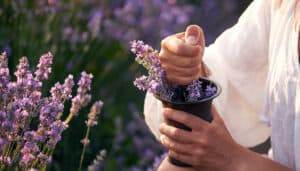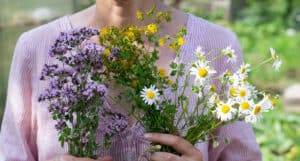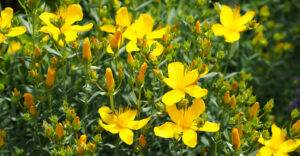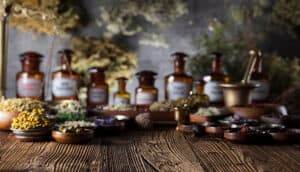Have you ever heard plants are medicine? The earliest forms of medicine were discovered using plants and natural elements. There is a growing trend of people realizing we got it all wrong and are heading back to nature. By understanding that there are natural ways to heal some ailments before you head to the pharmacy for a bottle of strong medications, many are seeing the advantages of natural medicines.
Essential oils are oils derived from plants with wonderful and captivating smells. Essential oils are extracted from plants in a few ways; they are a very concentrated extract from plants to be used in many ways.
In this article, I will discuss the plants you can grow to create your pharmacy of essential oils on your farm, in your garden, and even inside your home. Essential oils have incredible powers that few know about, from healing to cleaning and even repelling pests. Here are 10 of the best essential oil plants to grow.
Tea Tree
Melaleuca alternifolia, now known as the Tea Tree, produces one of the most versatile Essential Oils. This powerful oil was first discovered in Australia, where native people were found to make tea out of the leaves by soaking them in boiling water. It was here where they coined the name tea tree, not to be confused with the tea we are accustomed to drinking. They are coastal trees, but in South Africa, they are grown further and further inland.
It is a Pungent Oil extracted via steam distillation of the plant leaves; the oil is not found in the stem or roots. It is a high-yielding plant and one of the world’s most cultivated essential oils. The tree is reasonably fast growing and grows back after being cut down each time, growing back with more stems holding more leaves, so your yield improves. Hydrosol, the water by-product from steam distillation, is also an excellent product.
They can be grown in rows or single lines as a windbreak, boundary, or windbreaker. Using Compost, mulching, watering, and weed management, they will flourish, and once their strong roots have been established, you will have an oil-yielding tree for many years. It is harvested commercially by cutting the tree at the base, chipping, and steaming the entire plant. In gardens or small production units, cutting the plant at the bottom and stripping the leaves for steaming is the best practice, shredded or whole.
Tea Tree Oil has many uses. It is a fantastic antiseptic. It rivals the best antiseptic ointment when diluted with a carrier oil or vitamin-based cream like E45. Mixed with a cream or carrier oil is an excellent treatment for sunburn, burns, insect bites, rashes, and athlete’s foot. It can also be mixed into shampoo to treat itchy scalp and dandruff and added into homemade soaps and shower gels for the best clean and is an excellent mosquito repellant. I put it in shaving cream as it soothes razor burn. When mixed into Pet Shampoo, it controls fleas and ticks. Just ensure not to put it near open eyes.
In the home, added to hot water makes a fantastic antibacterial household cleaner that not only cleans and sanitizes but also is a tremendous flying insect deterrent. Flies, cockroaches, moths, termites, and ants hate tea tree oil.
Hydrosol is an excellent termite and garden pest deterrent in the garden and farm. I even used it on my young tea trees, whose roots got attacked by termites. A few drops of tea tree oil mixed with hot water and allowed to cool is the same as hydrosol and can be used as such.
Lavender
Lavandula augustifolia is one of the most beautiful plants in nature. With its striking purple color and intoxicating aroma, lavender is quite easily the most popular fragrance on earth. They are used in almost all cosmetic products where scent plays a vital role. It’s the lavender essential oil that brings these products to life.
Lavender, which is by nature a bushy shrub, can be grown indoors and outdoors as seedlings. It is an excellent yielding plant as you can harvest this perennial, and it will simply regrow, and you get a lot of foliage from a single plant. You plant them as seedlings around 4 ft apart in rows and 4ft between rows to allow each plant space to grow. They can grow up to 4 ft in diameter and around 4ft high. Growing organically is best to ensure you introduce no harmful chemicals to a product you want to be as natural as possible.
The oils found in the flowers usually bloom in summer in that characteristic purple blanket. It is then harvested by cutting the long flower-bearing stems and using steam distillation to extract the essential oil. The oil will match the color of the flowers, and the smell will be highly concentrated. When I began my journey growing essential oil plants commercially for oil production, lavender was quickly my favorite crop to grow. The allure of that final product, its color, and its smell make farming it so exciting as you wait for that oil.
The oil is one of the favorites used by herbalists, aromatherapists, and home users to treat stress and helps one to sleep and relax. It is a standard oil added to hot tubs and baths at luxury hotels and mixed with wax or in a diffuser is excellent to help children relax and sleep as well.
Tea Tree oil mixed with a carrier oil like coconut or olive oil makes one of the best massage oils. Using this oil must be done with caution as it can induce allergic reactions if one is allergic to lavender. The oil can also be mixed into homemade soaps or into home cleaners to make the house smell relaxing. Dripping into potpourri is a straightforward way to gently infuse the scent into your home.
Lavender doesn’t only need to be turned into essential oils; it is also used in teas, decorations, and as a pot plant. However, essential oil is the best way to go if you want to get the most out of the lavender’s essence. Unlike the raw plant, the oil is not for consumption, so please refrain from ingesting it.
Peppermint
Mentha Piperita is another favorite of mine and one that I love to grow and by far the easiest to grow. Peppermint is the cross between spearmint and watermint. It has a cool refreshing smell, and the plant grows as a lush green perennial which grows very fast provided it has water and enough feed through Compost or organic matter in the soil.
It has a very aggressive root system, like a weed, and becomes a very thick mat of foliage in a short time. It is the best essential oil crop to start with as it is very forgiving, fast-growing, and yields well. To start growing it, you can plant seedlings spaced apart in your bed or field. Bear, it will close reasonably quickly, but if you want a fully grown crop, it is best to plant it less than 1 ft apart. No need for accurate rows and spacings; it will be non-existent when it takes over. It is invasive and will grow out of its boundaries. Cut it back or pull and replant it in another area instead of buying new plants. Composting is the best way to fertilize, and simply just water often, especially on hot days. It grows back very quickly, so you will be harvesting often.
Harvesting of peppermint is done with scissors or a knife. Cut a few inches off the ground, stack, and take to the distillery. Peppermint is also best extracted by steam distillation. In my bigger fields, I use a hedge trimmer. It is the most efficient harvester.
Being one of the only edible essential oils makes it one of my favorites. The raw leaves are also delicious, and I often find myself sucking them as it is the only way to taste an authentic peppermint taste. It is also the best way to treat a stomach bug, IBS, gas, and constipation. It is also excellent for headaches.
It can, unlike most other essentials, be taken orally. I like putting it in cooled boiled water for Stomach ailments, and for headaches, I make a “Mockito,” a cocktail of Lime or Lemon, peppermint oil, water, and lots of ice. The “Mockito” is also the best cure for a hangover.
It also can be used in a bath or diffuser for its refreshing smell that is close to a fresh-cut grass smell when burned in a diffuser. It is an essential oil plant I will always grow.
Chamomile
This one is new to my arsenal, but I cannot believe it took me so long to get into it. We all know the calming effects of Chamomile tea, but only a few are aware of Chamomile essential oil.
There are four types of Chamomile: the German (Matricaria recutica), The Roman (Chamaemelum nobile), The Maroc, and the Cape. A daisy-like flower, the plant can be grown by sowing seeds into a bed. They don’t need accurate row spacings; they will grow like flowers and fill in a bed or field. Good Compost and organic matter are required to make the plant lovely and lush with lots of flowers and leaf matter. It is essential to water well but not over water, especially in winter, which could rot the roots. During summer, the heat and sunlight will allow the plant to photosynthesize. They yield very well, so it is a plant that works well for small gardeners and commercial farmers. Again organic growing methods are the way to go here.
Harvesting is very interesting as Chamomile is harvested for two products. Firstly the flowers are harvested and dried for chamomile tea. The Chamomile tea industry is enormous, and the demand for organic Chamomile is good. Whether you use the flowers or sell them to tea makers, they make an excellent brew. And then there is the harvesting of essential oil. Cut them down like you would the peppermint using a knife, or for bigger patches, a brush cutter or hedge trimmer will do the job. Stack and take to the distillery.
Chamomile essential oil is also, like the others, extracted most efficiently with steam distillation. After harvest, move the cut plants to the distillery. The oil has a solid and concentrated chamomile smell.
Chamomile is an excellent natural remedy for anxiety and stress. Like lavender, Chamomile can also be used to treat insomnia. Its effects on anxiety and stress are well documented and marketed primarily by Chamomile tea producers. Adding it to a steaming hot bath combined with lavender as they complement each other and work together for boosted stress relief. It is also well known for its anti-inflammatory properties and works effectively when applied to skin lesions or other skin conditions like eczema. However, mixing with a carrier oil or cream is crucial before applying it to the skin. My wife suffers from eczema, and Chamomile mixed with E45 cream and some freshly extracted Aloe Sap (Aloe Vera is great) is one of the most effective remedies we can find. I also use this mix on my Jack Russel, who suffers from rashes on his belly.
Chamomile is a must for anyone wanting to start experimenting with essential oils, and my only frustration is that I didn’t look at it sooner. Another oil similar to Chamomile is Lemon Verbena, which has similar healing properties. However, Chamomile is easier to grow, and oil yield is better.
Eucalyptus
The last essential oil plant to make my top five to grow yourself was tough. There are a lot of them which possess their magical powers. However, I went with one I have a lot of experience producing, which is very common. Eucalyptus globulus Is the most common, although there are many varieties. It is a tree and can grow very large. However, I recommend cutting it back when harvesting so you can keep the size manageable and avoid getting professional tree fellers later on.
They can be grown from seed. However, this is quite a long journey that can be cut down marginally by purchasing a sapling already a few feet tall. Depending on space available, you can grow a few depending on your oil requirements, but ideally, I’d recommend starting with two trees planted around 32 ft apart. Plant into well-drained soil with a good compost that will feed the seedling/sapling while it establishes. Ensure you water and keep weed free to get the most growth out of your trees. Use organic methods to grow to keep your oil as natural as possible.
Wait until the tree is adequately established and around 8 ft tall to harvest, with lots of leaves. The oil is in the leaves. You can cut the main stem to 7 ft to avoid it growing too tall, encourage the plant to side shoot, and keep the tree at a manageable length. Prune all leaves and then take them to the distillery.
Eucalyptus is extracted by steam distillation and also is a very good-yielding plant as it doesn’t need much care other than weeding once it is properly established. Depending on your area, the leaves grow back relatively quickly, and you can harvest as you need depending on your requirements.
The oil is best for flu, nasal congestion, and respiratory problems. Inhaling by diffusing hot water for a bath or through an essential oils diffuser works very well. The oil is powerful and opens up airways so effectively. In South Africa, many rural folks will add Vicks to a bowl of boiling water and inhale it with a towel draped over their heads to ensure all the steam is inhaled. Eucalyptus works much better than Vicks, especially for nasal congestion and sinus. It also makes an excellent insect repellent; adding some to hot water and spraying around the house will keep most insects away. However, if you are using a diffuser in the home, the diffuser will do the job of deterring insects. Tea Tree Oil works better as an insect repellent, but Eucalyptus works just as well if you don’t have Eucalyptus.
Eucalyptus is a plant that, once established, requires very little maintenance, and the essential oils are worth the effort of growing a tree or two, and by keeping them short, they are easy to harvest. As I said, it was a tough choice, but the Eucalyptus is an excellent option for the starter grower.
The top five plants I have chosen to be in my top five may differ from another grower. However, these are the best for someone wanting to start. If they wish to be a small hobby grower with a small hobby or a small commercial grower with a bigger still, everyone can benefit from these five plants. They can then have a whole arsenal of home remedies to sell or use. Go ahead and grow your pharmacy.





